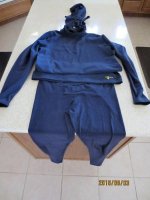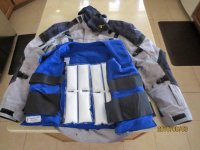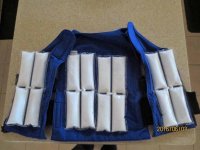I recently moved to Southern Utah from California and have found the summer heat a bit much to deal with.
The only thing I can add is that 93 degrees is the magic number. Up to that air temperature, more air over your body will cool you. Above that number, more air flow will heat you up. If you gain 3 degrees you will be sick. If you gain 5 degrees you might die.
Sooooo Drink a lot of water and keep yourself wet. If you are wet, a mesh jacket will help at higher temperatures as the water evaporates. I also use the 'don't ride' method. I also have forgone my years of ATGATT doctrine.( All The Gear, All The Time. ) My logic is that if I am suffering heat stroke from wearing too much gear I will more likely have an accident that causes me to need ATGATT. Some guys I ride with are in loose shorts, sandals and a tank top. I don't go that far but try to hit a mid point where I have the essentials protected while still allowing my body to get air across it. And I carry a lot of water.
Jane and I recently completed a 6-day trip through Arizona that was quite interesting for its wide range of temperatures. The first day out from our base in So. Utah, we met up with some other riders in Oatman, AZ. On the way there, the temps were climbing into the 90's and we both removed our 3-season riding jackets (which are black and have some mesh panels but are not all mesh) because we were getting too warm. As Bob suggested above, ATGATT seems counter-productive if it causes overheating leading to heat-related brain fuzziness, so we left the jackets off as we rode south out of Oatman toward Lake Havasu.
I had on my Orvis long sleeve zip neck fishing shirt with high UV protection and a high collar
http://www.orvis.com/p/drirelease-long-sleeved-zipneck-casting-shirt/1r47 . For pants, I kept on my lightweight stretch jeans. Full modular helmet. As we neared Havasu, the temps crept over 100 and at times hit 104. I was warm, but comfortable (except for the tops of my thighs which got very hot as the jeans clung to my skin).
Jane on the other hand got very overheated and we had to stop at Havasu and seek some shade so she could chill out a bit. Her face was flushed. We hydrated her, dumped water on her and she just rested for about 1/2 hour in the sparse shade until she started feeling better. At that point, she also had put on her ice-water-soaked evap vest, which helped.
Eventually, we got back on the bikes and continued on our way through the desert toward Wickenburg, AZ, with temps still in the 3 digits for at least 3 hours. During that time, her evap vest dried out and no longer provided any cooling effect. Fortunately, by then the temps were dropping a little and we made it to Wickenburg without Jane feeling dangerously overheated.
A few days later, we were headed from Scottsdale to Globe, AZ with temps at times hovering near 100. This time, Jane was trying one of my fishing shirts alone and experienced much more comfort and no stress from the heat.
I'm not sure what conclusions to draw from this experience. We had not planned on encountering a heat wave of that magnitude in April so had to make do with what clothing and protection we had. In other words, we had worn 3-season jackets and not all-mesh jackets and pants. Fortunately, we had remembered to pre-soak our evap vests, which proved critical to Jane's well-being in the heat the first day (to lower her core temp) but of little use for distance riding once it dried out. I never used my evap vest and didn't feel the need for it. The Orvis fishing shirts turned out to be the most comfortable outerwear for both high heat riding and moderate temp riding (i.e. lightweight, breathable but excellent UV protection).
So, still researching this topic because we know desert riding will always be a factor in our Spyder touring adventures. But, also need to be able to protect from the cold on the same trip, without carrying an excessive amount of outerwear for changing conditions (our last day of riding through the mountains of northern Arizona, southern Utah temps hovered between 45-65 degrees with a strong cold wind to deal with).
By the way, constant hydration is important in the desert, as is moving forward for air flow. So we plan on getting Camelbacks or something similar to avoid having to stop in the shadeless desert to get a drink of water. I think what I'm going to look into is a lightweight wicking base layer (top and bottom) and a loose-fitting outer layer that provides excellent UV protection and reflects the sun as much as possible. I think the Orvis shirts may be good for the upper body, but I am still looking for a solution for the lower body (pants).
I think I'm going to ditch the evap vests; they just are not effective for long enough to make them practical for touring in the Southwest (where shaded rest stops with water are very few and far between). By the way our two dogs, in the pet trailer from Kompact Kamp, seemed to be very comfortable and not the least bit overheated as long as we kept moving. If we stopped for long though, we had to find shade.
I'll post as I come up with any solutions to pass along. Meanwhile, I'd welcome any comments from others who have learned to deal with the extremely hot, dry conditions of desert riding.
Addendum: in reading back through these posts I saw the reference to LD Comfort so looked them up. Their 1/4 zip mock turtle shirt
http://ldcomfort.com/long-sleeve-mock-zipper-top.html seems very much like my Orvis shirts, except in limited colors and a lot pricier.




